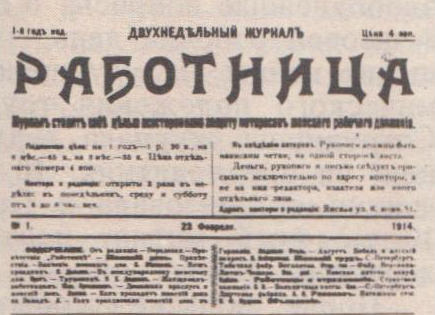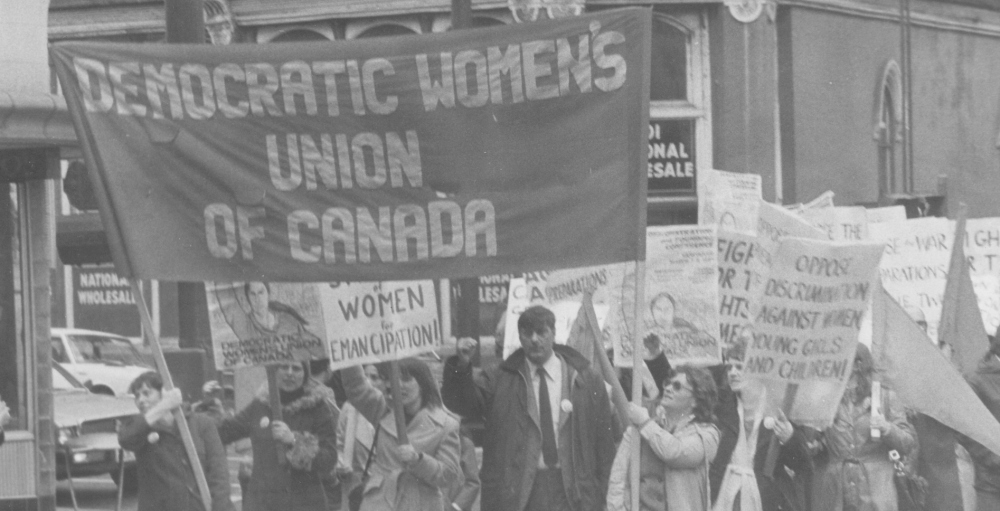International Women’s Day
Origins and History
Women from around the world gathered at the Second International Conference of Socialist Women in 1910 passed the resolution establishing International Women’s Day.
International Women’s Day was first celebrated in March 1911, with March 8 set as the official date in 1921. Ever since women fought for the right to vote in the late 19th and early 20th centuries, the essence of their fight has been political. They have put forward their claims on society as a matter of right, facing all kinds of state-inspired discrimination and violence against them and state-sanctioned attempts to relegate them to second, third and fourth grade citizenship based on brutal identity politics and exploitation. Women, however, speak in their own name and refuse to accept any limitations on their right to decide all matters which affect their lives. Their courage and determination in the front ranks of the struggle for a society which recognizes everyone as equal members of the body politic with equal rights and duties inspires everyone to also fight for the rights of all.
1907: German communist Clara Zetkin proposes the idea of an annual demonstration in support of working women and women’s rights at the First International Conference of Socialist Women in Stuttgart, Germany.
1909: A “Woman’s Day” is held in the United States on February 28, organized by the National Women’s Committee of the American Socialist Party. Demonstrations highlight the demand for women’s suffrage along with the rights of women workers, particularly in the garment trade. They also honour the thousands of women involved in the numerous labour strikes at the time in cities such as Montreal, Chicago, Philadelphia and New York.
1910: A resolution put forward by the German communist Clara Zetkin at the Second International Conference of Socialist Women in Copenhagen, Denmark is passed to establish International Women’s Day. More than 100 women delegates from 17 countries attend the conference, among whom are the first three women elected to the Finnish parliament.
This Second International Conference of Socialist Women reiterates the principles adopted at the First International Conference on the question of women’s suffrage. These principles provide the framework for the resolution to establish International Women’s Day to focus on the question of women’s political rights.
1911: Implementing the resolution adopted at the Second International Conference of Socialist Women, on March 19 rallies are held in Austria, Denmark, Germany and Switzerland, attended by more than one million women and men. “The vote for women will unite our strength in the struggle for socialism” is the call of these rallies. In addition to their demand for the right to elect and be elected, they demand the right to work, to vocational training and to an end to discrimination at work.
1912: Women in France, the Netherlands and Sweden take up the celebration of International Women’s Day. In the period leading up to World War I, these activities oppose imperialist war, reject the national chauvinist warmongering hysteria of the ruling circles and express solidarity between working women of different lands. For example, in Europe International Women’s Day becomes an occasion for speakers from one country to go to another country to deliver greetings.
1913: Russian women observe their first International Women’s Day on February 23 on the Julian calendar (March 8 on the Gregorian calendar). Conditions of brutal Czarist reaction prevent open demonstrations, however led by communist women, ways are found to celebrate the day. Women in Russia continue to celebrate International Women’s Day in various ways from 1913 to 1916. Many involved in organizing end up in Czarist prisons when the slogan “for the working women’s vote” becomes an open call for the overthrow of the Czarist autocracy.

First issue of Rabotnitsa (The Woman Worker) |
1914: The first issue of Rabotnitsa (The Woman Worker), a journal for working class women, is published in Russia. The Bolshevik Central Committee creates a special committee to organize International Women’s Day. Meetings are held in the factories and public places to discuss issues related to women’s oppression and to elect representatives to carry forward the proposals from these meetings in the new committee.
1917: In Russia, International Women’s Day is a time of intense struggle against the Czarist regime. Workers, including women workers in the textile and metal-working industries, are on strike in the capital city St. Petersburg. On March 8 (February 23 on the Julian calendar), thousands of women factory workers in St. Petersburg strike for bread and peace. They demand, “Bread for our children” and “Return our husbands from the trenches.” It marks the beginning of the February Revolution, which leads to the abdication of the Czar and the establishment of a provisional government that makes the franchise universal and recognizes equal rights for women.
Following the October 1917 Revolution, the Bolshevik government implements more advanced legislation, guaranteeing in the workplaces the right of women to directly participate in social and political activity, eliminating all formal and concrete obstacles which previously meant the subordination of their social and political activity and their subservience to men. New legislation on maternity and health insurance is approved in December. A public insurance fund is created, with no deductions from workers’ wages, that benefits all women meaning that neither women nor their children are dependent on spouses and fathers for their economic wellbeing.

Clara Zetkin (left) and Rosa Luxemburg, 1910 |
1920: V.I. Lenin has an important discussion with Clara Zetkin, which she recounts in the pamphlet Lenin on the Women’s Question, where he sets out the necessity for “a powerful international women’s movement, [established] on a clear theoretical basis.” He points out that in organizing women:
“The inseparable connection between the social and human position of the woman, and private property in the means of production, must be strongly brought out. That will draw a clear and ineradicable line of distinction between our policy and feminism. And it will also supply the basis for regarding the woman question as a part of the social question, of the workers’ problem, and so bind it firmly to the proletarian class struggle and the revolution. The communist women’s movement must itself be a mass movement, a part of the general mass movement. Not only of the proletariat, but of all the exploited and oppressed, all the victims of capitalism or any other mastery. In that lies its significance for the class struggles of the proletariat and for its historical creation, communist society.”
1921: March 8 becomes the official date for International Women’s Day when Bulgarian women attending the International Women’s Secretariat of the Communist International propose a motion that it be celebrated around the world on this day. The date is chosen to honour the women in the Russian Revolution, recognizing their role as a contribution to the struggle of women for their emancipation internationally.
In Turkey the day is first celebrated in 1921, underground, by communist women in Ankara.
1924-25: In China, the first public celebration of the day is held in the southern city of Guangzhou, when 2,000 people gather for a mass meeting at which speakers call on women to unite behind the struggle against imperialism and feudalism in the name of personal and national liberation.
Word of the Guangzhou mass meeting spreads throughout China, and the following year women from around the country gather in Beijing to protest the government’s refusal to grant women the right to vote.
1928: The first International Women’s Day rally is held in Australia. It is organized by communist women to demand an eight-hour work day, increased wages, paid annual leave and a living wage for the unemployed.
1930s: In Mexico, International Women’s Day is first celebrated during the 1930s.
1936: Spanish communists organize a massive demonstration in Madrid on March 8 demanding protection of the Spanish Republic against the growing fascist threat.
1937: Spanish women demonstrate against the fascist forces of General Francisco Franco on International Women’s Day.
1943: Italian women mark International Women’s Day with militant protests against fascist dictator Benito Mussolini for sending their sons to die in the Second World War.
1945: Immediately after the Second World War, the tradition of International Women’s Day is revived all over the world. It is marked with official celebrations in the republics of the then-Soviet Union.
1951: In China on International Women’s Day, more than 100,000 demonstrators take to the streets of Beijing and Shanghai to protest the post-war American occupation of Japan.
1960: “La Emancipación de la Mujer es obra misma de la mujer” (“The emancipation of women is the deed of women themselves”) proclaims a Mexican poster created for International Women’s Day. The poster celebrates the 50th anniversary of the beginning of the Mexican Revolution and also pays tribute to the victory of the Cuban Revolution the previous year.
1960s-70s: With the upsurge of the movement of women for their rights in the 1960s and ’70s International Women’s Day re-emerges as a day of activism for women’s rights and empowerment.
1972: In Australia, large International Women’s Day marches begin in 1972 with several thousand women rallying, particularly in Sydney and Melbourne.
1975: The United Nations designates International Women’s Year and celebrates International Women’s Day for the first time.
Two years later the UN General Assembly adopts a resolution proclaiming a United Nations Day for Women’s Rights and International Peace. The UN avoids presenting March 8 as a day of struggle for the rights of women and calls it “a time to reflect on progress made” and “celebrate acts of courage and determination of ordinary women.” This is the content taken up since that time by official circles in many countries, including Canada whose policies shamefully discriminate against women in all spheres of life but it nonetheless says it defends “feminism” and that it is making progress.
1981: The Democratic Women’s Union of Canada is founded under the leadership of the Communist Party of Canada (Marxist-Leninist) on March 8 in Vancouver, to organize women to play their leading role in the emancipation of the working class, the necessary pre-condition for their own affirmation.

1986: Within two months of the fall of the 30-year Duvalier dictatorship in February, there are two women’s marches demanding justice for all Haitians in general and for women in particular. Almost 2,000 women march in the remote village of Papay where a peasant movement has been organizing underground, while on April 3 in Port-au-Prince, more than 30,000 women from all social sectors take to the streets.
2019: The 10th Congress of the Federation of Cuban Women (FMC) concludes its proceedings on International Women’s Day. More than 4,300,000 women are members of the Federation. Women represent 53.2 per cent of the positions held in the National Assembly of People’s Power in Cuba and constitute 48.4 per cent of the members of the Council of State.
In Canada and around the world, International Women’s Day today is marked to celebrate the courage and role of women in the front ranks of the striving of the peoples for empowerment and rights recognized on a modern basis.

|

|
[BACK]





